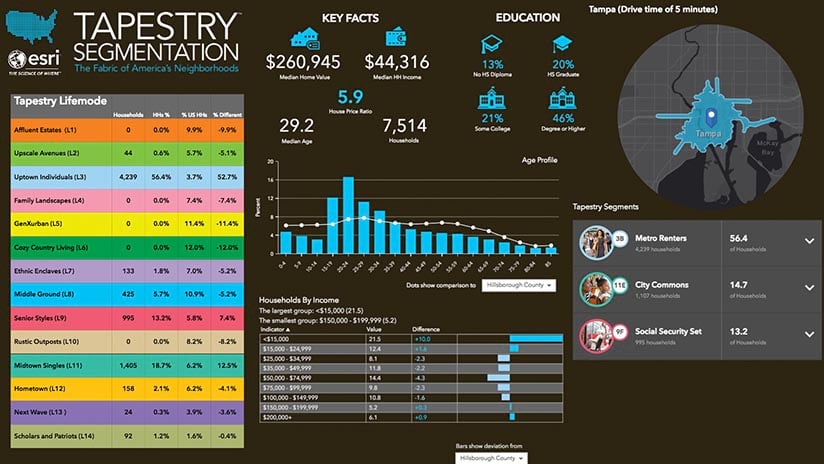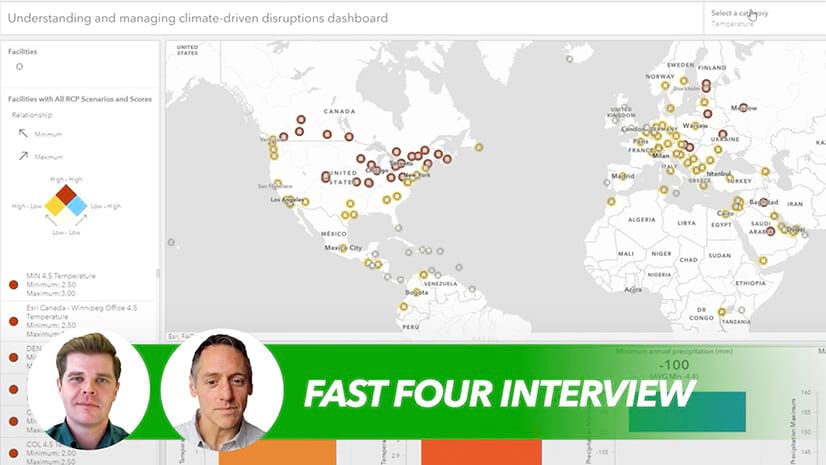The unemployment rate dropped below 4 percent this spring, a rate not seen since the year 2000. That gives workers something they haven’t had in quite a while: options.
While the great recession of 2007–2010 tethered employees to specific jobs, industries, and employers, today’s expanding economy affords those employees the power to choose exactly where they want to live and work. The most innovative companies have discovered that location data can be a critical asset in attracting and retaining top talent.
Of course, wages and benefits remain prime concerns for any person cashing a paycheck, but so too are lifestyle and the cost of living. Millennials, the single largest portion of the US workforce at 76 million people, are looking for jobs that fit their needs and life goals. If the compensation packages of employers are comparable, why would Millennials—or workers of any generation—reside and work in communities where housing is unaffordable or doesn’t offer the amenities they desire? Why live in more affordable locales but commute long distances for a job when the employer can move those jobs to where people prefer to live?
“I don’t” and “I won’t,” are the answers increasingly coming from workers. More than 6 in 10 professionals polled by the staffing firm Robert Half said changing roles every few years is beneficial, a jump of more than 22 percent from a similar survey four years ago.
The result is they are moving on, leaving the employer to recruit and train replacements, which is inefficient and can be cost prohibitive. Research indicates that replacing a salaried employee costs up to nine months’ pay on average.

Cost of living often is top of mind for those considering relocating for work. The Internet is rife with job sites and calculators that offer COL comparisons.
With stakes that high and employees feeling emboldened, companies might want to gather location intelligence on the communities in which they operate. With access to data such as median housing prices, education levels of the available workforce, and commute times for prospective employees, employers can understand how well their salaries compare to those in other geographies where employers are competing for the same talent pool.
Employers Must Understand Worker Needs
The bottom line for employers is they cannot take their workforce for granted and assume employees will stick it out even in undesirable locations. Some did in October 2009, when the unemployment rate peaked at 10 percent and worker mobility was virtually nonexistent, but today’s economy is much stronger and filled with new job types and work options.
Moving forward, employers should focus more on understanding and meeting reasonable and aspirational lifestyle needs of their employees. Likewise, they need to be well acquainted with the strengths and weaknesses of the communities in which their employees reside, and collaborate with local governments to further align social amenities with the expectations of prospective employees. Like employees, companies can move to areas that are better places to do business.
A geographic information system (GIS) can provide a baseline for such discussions and decisions. Combining data on demographics, lifestyles, aspirations, and consumer spending, a modern GIS provides location intelligence on employees’ needs and expectations. Ranking the factors that are meaningful to existing and prospective employees enables a business executive to understand how competitive a company is in the search for talent.
For example, business executives could assess a community through key metrics such as median house prices as a proportion of median household income, with a backdrop of the education levels of different age groups, school district ratings, and access to natural spaces and community facilities. They could rate each community using different commuter models—say, a 10-minute drive, 15-minute train ride, or 25-minute bike ride. These are the types of criteria Amazon is using in its closely followed search for a new headquarters.
Insightful corporate decision-makers can dig deeper with GIS’s smart mapping technology, looking at how the price of homes, food, entertainment, and eating out vary across locations. Workforce planners can take that analysis down to the neighborhood level, or they can widen the scope and explore projections for a region. Either way, this information provides an employer a richer understanding of an area’s economic trajectory, attractiveness, and cost of living.
Understanding and analyzing these factors is important to employers because they matter deeply to employees. A recent study by the University of Southern California found that cost of living, including housing, is a major factor in the recruitment of workers, including high-level senior management. Nearly 60 percent of the Los Angeles-area employers who responded to the survey said the region’s high cost of living hurt employee retention, and 64 percent said they include cost-of-living adjustments when hiring top managers. Changes in house prices and wage growth are not uniform across geographies, so communities can quickly become more or less affordable. GIS enables employers to monitor the attractiveness of an area as purchasing power, disposable income, and home prices rise and fall.
Millennials Move from Job to Job
Millennials, or those born between the early 1980s and early 2000s, are not as loyal to employers as their predecessors, and are more apt to move around.
Among financial considerations, older Millennials recently ranked high cost of living as their biggest burden. As Millennials age and become parents, cost of living becomes an even more important factor in choosing their jobs and where they raise their families. This recently took on greater importance for Katharine and Kris Kennedy, a Millennial couple who decided to move to Florida from New York City two years ago because they wanted to have a child, buy a home, and be closer to family. She gave birth to a girl, Madison, on August 31, 2017.
“We loved New York, but it is almost impossible to own there,” says Kennedy, 32, a high-tech saleswoman who first relocated to Fort Lauderdale, but then moved less than a year later to Tampa after landing a better job there. An archetypical Millennial, she has worked for five tech companies since graduating college.
Tampa, she says, fits her young family’s needs because it is affordable, has a warm climate, is close to beaches, and is home to plenty of fellow Millennials. Both she and her husband, a Realtor, have short drives to their respective offices, though they’re able to work from home as well. In New York City, they commuted by subway and cab, trips that could take a half hour or more, depending on the time of day.
Housing prices often are responsible for long commutes because homes in the suburbs invariably are cheaper than those in the downtown core or the area’s main employment base.
As the Kennedys illustrate, commutes are a big deal to members of the workaday world. Nobody likes sacrificing hours getting to work. People living in large, expensive metro areas like New York City, San Francisco, or Seattle often drive or take public transit for 90 minutes or more to get to the job because they’re limited by where their salary allows them to live. The average commute nationwide is around a half hour, but many workers travel far longer in the early mornings and late nights from affordable “bedroom” communities.
In an effort to reduce commuting, professionals like the Kennedys will move away from expensive metro areas to smaller cities—especially those in low-tax states, such as Florida or Texas.
Smaller cities and lower-tax locations also tend to feature lower housing prices. One simple way to compare cost of living is to divide an area’s median home value by its median salary. In Manhattan, that ratio is 22 (the median home value is $1.3 million). In Tampa, where the median house value is just shy of $261,000, the ratio is 5.9. (See the image below for a GIS analysis of Tampa.) For other smaller cities like Columbus, Nashville, and Indianapolis, whose highly affordable, quality lifestyles make them candidates for Amazon’s HQ2, that number is even less.

Cost of Living and Lifestyle as Important as Ever to Professionals
There’s little doubt that workers are taking lifestyle factors into consideration. Career-building or job-finding websites, such as indeed.com, list not only salary information of prospective employers, but also cost of living data, alongside comments about workplace culture.
Many job applicants are arming themselves with community and lifestyle information when they seek out new employment. That wasn’t the case five years ago, when the economy wasn’t as strong nor jobs as plentiful. Applicants couldn’t be as selective about where they worked, especially if they were unemployed.
Employers can use similar data not only when deciding to hire a worker, but also for possible business relocation. The real estate divisions of many companies already employ GIS to determine prime locations for retail stores.

Just putting a 20 percent down payment on a home in Manhattan, where the median home price is $1.3 million, can amount to a daunting 4.3 years’ worth of salary.
A savvy executive could also leverage GIS to identify where good potential employees might be living. GIS contains information of where particular groups of people live, their jobs skills, education, current wages—as well as the types of firms that operate in an area. Smart businesses can use location intelligence to identify pockets of talent and underemployed workers and hire them.
How Long Will a Community Be Affordable?
Given the costs of running a business, it is important to know how affordable a community is compared to local, regional, or even national competitors. Will it remain affordable enough to entice a workforce to your enterprise? As jobs, workers, and salaries increase, will it become more costly as it becomes more attractive? For many communities, this is a constant challenge: the most sought-after area eventually becomes the least affordable, and the characteristics that made it so attractive in the first place are lost. But the companies that use location intelligence to anticipate where employees want to be tend to gain an edge on the competition.
In the end, it’s not about wages, the cost of housing, the schools and parks, the length of a commute, or the location of the office. It’s actually about all those factors. Combined, they play a critical role in the success of every business, and whether its workforce will be stable or plagued by turnover.
(For more on the interplay of cities and commerce, listen to this podcast with Geoffrey West, author of the book Scale.)
Photo courtesy of Matthew Henry










